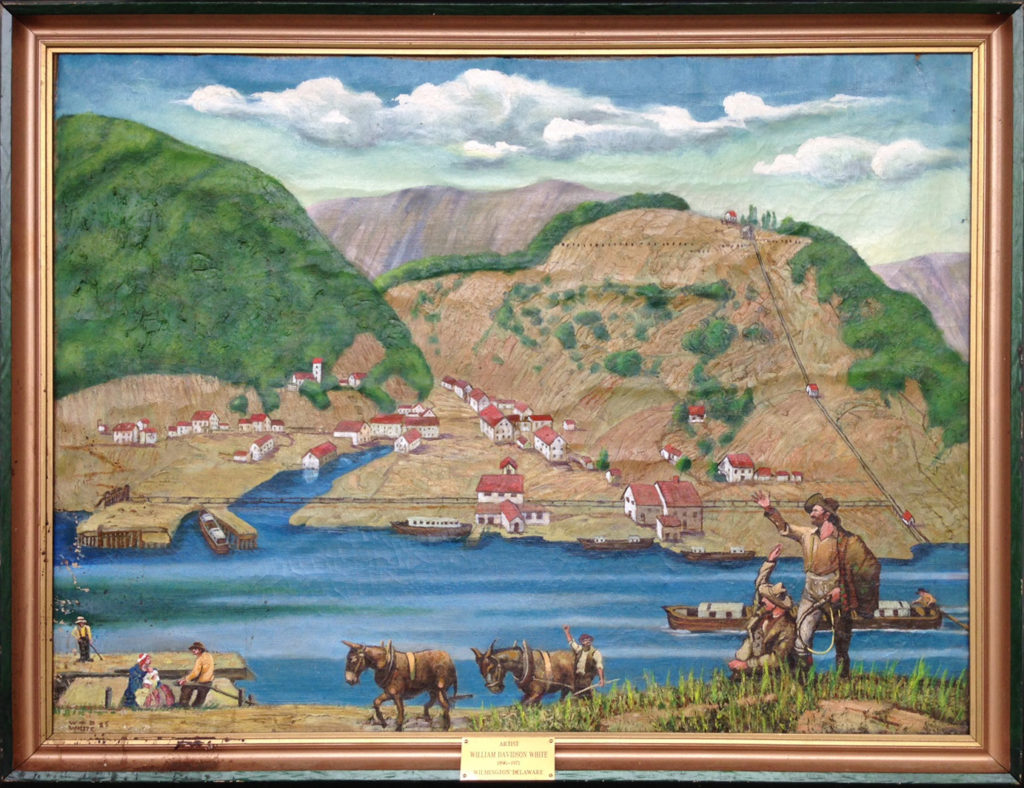 Title: Artist: William D. White
Title: Artist: William D. White
Title: When Old Mauch Chunk Was Young
Size: 30 x 40 inches
Medium: Oil on linen
Publication: October, 1925, The Explosives Engineer, Hercules Powder Company
When Old Mauch Chunk Was Young
This large painting is one of four illustrations executed for a picture article titled, “A Century in Anthracite Transportation.” The scene depicts the transportation of anthracite coal from Summit Hill, Pennsylvania down the Lehigh River to Philadelphia. The completion of a canal beginning at Mauch Chunk (renamed Jim Thorpe in 1954) made the shipment of coal in barges commercially successful.
I first saw this painting in 1991. Steven Leech and I had collaborated on an issue of Dreamstreets magazine in 1991 featuring William D. White. Leech, the founder and editor of Dreamstreets, owns a painting White had given to his father when they worked for the Federal Arts Programs in the 1930s. As a result of the feature issue, we were contacted by a man looking to sell a William D. White painting he had acquired from a friend with a “clean out” business. The painting had come from a library, but he would not say which one.
Leech and I were shown the painting in a warehouse in Elsmere, Delaware. The man also had a binder of references to White’s biography and work he had gleaned from the Delaware Art Museum and Wilmington public library which, in his mind, justified his asking price of $2,500. I was shocked by the garish colors and figure outlining that were inconsistent with White’s style and palette. The man said he had hired an amateur painter to “freshen up” the painting which was an accepted practice in the art world. I was so angry I replied that if White were alive today, he would put his foot through the canvas.
Over 20 years passed, and I decided to try to find the painting. I tracked down the man who wanted to sell it for $2,500, only to discover he had sold it to a local auctioneer for roughly $200 shortly after meeting us. The auctioneer’s son currently ran the auction business. From him I learned that the painting had been stored in a warehouse without climate controls for almost 20 years. Even though time had not been kind to the artwork, I purchased the painting in 2013.
When I removed the painting from the frame and realized its condition, I knew I could not afford the cost to restore it, nor could it be shown in the retrospective exhibition, William D. White: Vision and Voice of the Artist Revealed, scheduled to open at the Biggs Museum of American Art in Dover, in March of 2015.
Many condition issues were apparent. In places along the edges, the canvas had torn away from the tacking nails used to hold the canvas to the stretcher. There was puckering of the canvas around some of the edges and “tenting” of the paint layer in areas. Some abrasion has also occurred. The obverse side of the canvas was painted with black paint and plastic tape.
While the William D. White exhibition was on display, I participated in a day-long Symposium, where I met Dr. Joyce Hill Stoner. One of the nation’s leading art conservators, Joyce previously served for 15 years as director of one of only three graduate programs in the country that train conservators of paintings. She currently teaches painting conservation through the University of Delaware and Winterthur Museum.
At Joyce’s request, I took Old Mauch Chunk to a Conservation Clinic held at Winterthur Museum on October 8, 2015. She viewed the painting under ultra-violet light to determine the extent of overpainting. To my delight, Joyce Hill Stoner will supervise a team of summer interns in the paintings conservation studio of Winterthur Museum carrying out the treatment of William D. White’s painting. The team will be led by Charlotte Adams Brooks, who has worked at the Brooklyn Museum of Art and will return to Brooklyn in the fall.
Conservation is scheduled to begin on June 1, 2016.
Stay tuned for updates on the conservation progress.
NOTE: A Glossary of Art Conservation Terms is provided in a separate link.